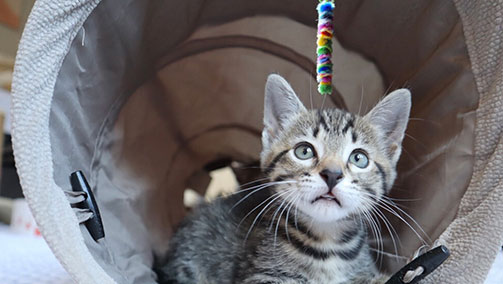Introducing your new cat to your resident cat
Introducing your new cat to your resident cat
Congratulations on adopting your new cat!

How do you successfully introduce a new cat into your household if you already have other pets? Cats can be territorial, so bringing a new kitty home to meet Fido or Fluffy can be a hair-raising experience for not only the owner but also the resident pets—if not handled correctly. A peaceful relationship between new and existing feline or canine housemates requires time, patience and work. The introduction process generally takes a few weeks before the pets are all cohabitating peacefully. At times, though, it can take several weeks. The trick is to do it slowly and cautiously…and follow the guidelines below.
Remember:
- Cats like routine, not change Your resident cats’ behavior may initially change when you first bring the new cat home. Most common is hissing, growling, hiding or fighting among resident pets. Your current cats may even act differently toward you by displaying aggression or ignoring you all together. With your new cat in his “safe room,” the new and resident cats will all have the opportunity to become familiar with each other’s’ scents while safely separated by a door. As they begin to acclimate to each other, the cats will feel less threatened and, with time, the negative behavior should dissipate.
- Introduce Cats First Always introduce a new cat to the resident cats before introducing him to the resident dog(s). In most cases, the cat to cat introductions will be more harried, with the cat to dog introductions being somewhat easier.
- Every cat has their own personality The ability of animals to get along together in the same household depends on their individual personalities. There will always be one who dominates. A new cat will often upset the existing pecking order or the old cat or dog may feel it necessary to establish dominance immediately. Wise handling of the “getting acquainted” period is an important factor in the successful introduction of a new cat.
- Patience is Key The first week or two may be hectic, frustrating and time consuming. Be patient. The adjustment will take time.
Safe Room:
Isolate the new cat in a separate “Safe Room” It should be closed off from the other pets (make sure the door is securely shut and doesn’t open easily). This smaller, confined area will help the new cat to feel safe and adjust more quickly to his new home. Provide a litter box, scratching post, toys, food, and water in the new cat’s room. This separation will also give your current pet’s time to get used to the new cat’s smell and the idea of having a new occupant in the house. During the first week, the only interaction that your new cat and resident cats should have is playing paws under the door.
Introducing to Resident Cats:
The new cat and resident cats should have no face-to-face interaction for the first week. This will allow the new cat time to get comfortable with his new environment and family. The stress of a new environment can cause a cat to show signs of an upper respiratory infection (watch for sneezing, eye or nose discharge) or diarrhea. Watch to make sure that the new cat is eating well, drinking and using the litter box. In almost every case, a cat that does not use his litter box is suffering from a medical condition. Any instance of inappropriate elimination (outside of the litter box) should be followed up with a visit to the vet.
Start introducing the smells of each cat to the other You can do this by brushing all of the cats with the same brush to get their scents on each other. Share blankets and litter boxes. Also, try feeding them each a special treat on either side of the door. Doing so will help each cat to associate the smell of the other cat with the positive experience of eating the treat (usually wet food works best).
Do not rush this process. It is very important to the long term harmony of their relationship that the introduction process proceed at a pace comfortable for each of the cats.
Monitor all interactions closely during the first weeks. Do not leave the cats alone unsupervised until you are comfortable that there will not be aggressive behavior displayed by any of the cats. During the first few weeks, the new cat should stay in his “safe room” when no one is home to supervise.
If interaction among the cats deteriorates instead of improving, return the new cat to his “safe room.” At this point you will need to start the introduction process again, this time, taking more time at each stage.
Tips to Encourage or Maintain Harmony:
To speed acceptance of a new cat, after following the above introduction processes, try feeding the cats at opposite ends of room. Gradually, over time, move the food bowls closer together. After feeding them side-by-side for a week, the cats should be ready to roam throughout the house freely.
Add a few drops of Bach Flower Remedies to each water bowl. Add additional drops as needed when the water is changed or replenished. This is a homeopathic treatment that will not have any effect on those pets that drink the treated water if they are not displaying the targeted behavior. You can purchase Bach Flower Remedies in different “flavors” at Whole Foods Stores and most health food stores.
“Holly” helps to quell anger
“Rock Water” works well with overly dominant animals
“Vine” helps to calm a bully
“Walnut” helps adjust to change
“Willow” addresses any feelings of resentment
Provide plenty of safe, comfortable sleeping/nesting places if you have several pets…cats especially need their space. They are not as social as dogs and often prefer isolation at times.
Maintain separate litter boxes (they eventually may share). The general rule is one litter box for each cat plus one.
Make sure litter boxes are placed in quiet, easily accessible locations that do not present opportunities for a cat to be cornered by other pets. While litter boxes should be accessible to the cats, they should be out of reach of any resident dogs.
Keep In Mind:
Unfortunately, in spite of your best efforts, sometimes the resident pets will not accept the new cat into their home. After a month of working through the techniques listed above, if your pets have not progressed past outward displays of aggression, it is time to consider the possibility that the new cat may not be able to integrate into your family. If this turns out to be the case, unless you are willing to maintain separate living quarters for warring pets, you may need to return the newcomer. Before making this difficult decision – or if you have any concerns at all, we absolutely encourage you to reach out to our staff for some tips.
Additional Resources:
www.4PAWSrescue.org
www.humanesociety.org
www.catbehaviorassociates.com
www.americanhumane.org


